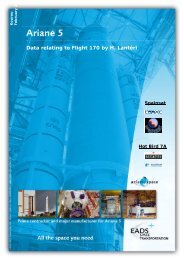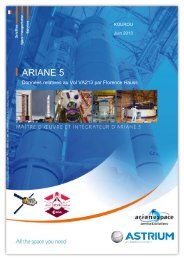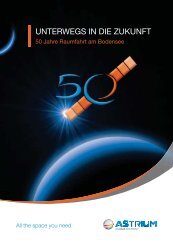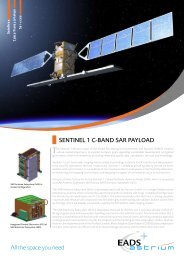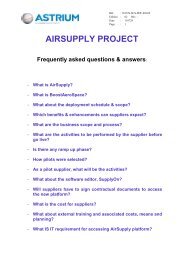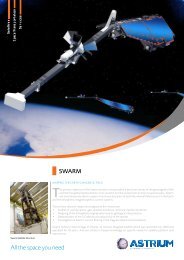Flight 207: Ariane 5 ECA/Echostar-17 - Astrium - EADS
Flight 207: Ariane 5 ECA/Echostar-17 - Astrium - EADS
Flight 207: Ariane 5 ECA/Echostar-17 - Astrium - EADS
Create successful ePaper yourself
Turn your PDF publications into a flip-book with our unique Google optimized e-Paper software.
Data relating to <strong>Flight</strong> <strong>207</strong><br />
<strong>Flight</strong> phases<br />
Taking H0 as the basic time reference (1 s before the hydrogen valve of the EPC Vulcain engine<br />
combustion chamber opens), Vulcain ignition occurs at H0 + 2.7 s. Confirmation of nominal<br />
Vulcain operation authorises ignition of the two solid propellant boosters (EAP) at H0 + 7.05 s,<br />
leading to launcher lift-off.<br />
Lift-off mass is about 774 tons, and initial thrust 13,000 kN (of which 90% is delivered by the<br />
EAPs).<br />
After a vertical ascent lasting 5s to enable the launcher to clear the ELA3 complex, including<br />
the lightning arrestor pylon in particular, the launcher executes a tilt operation in the trajectory<br />
plane, followed by a roll operation 5 seconds later to position the plane of the EAPs<br />
perpendicularly to the trajectory plane. The launch azimuth angle for this mission is 88° with<br />
respect to North.<br />
The “EAP” flight phase continues at zero angle of incidence throughout atmospheric flight, up<br />
to separation of the boosters.<br />
The purpose of these operations is to:<br />
• optimise trajectory and thus maximise performance;<br />
• obtain a satisfactory radio link budget with the ground stations;<br />
• meet in-flight structural loading and attitude control constraints.<br />
The EAP separation sequence is initiated when an acceleration threshold is detected, when<br />
the solid propellant thrust level drops. Actual separation occurs within one second.<br />
11




